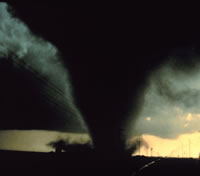 Severe storms strike quickly! Thunderstorms can produce heavy rain, strong winds, lightning, hail and tornadoes. You may need to respond promptly to one of these threats posed by a storm in your area.
Severe storms strike quickly! Thunderstorms can produce heavy rain, strong winds, lightning, hail and tornadoes. You may need to respond promptly to one of these threats posed by a storm in your area.
The National Weather Service, in cooperation with the broadcast media, BuffaloWatch and the local spotter system, will provide you with the warnings you need to quickly respond. If you listen to the media, you will know when a storm is approaching your area and you will know if you need to take protective action.
Watch or Warning
A Severe Thunderstorm Watch means conditions are right for the  development of storms. Stay tuned to the media for further advisories.
development of storms. Stay tuned to the media for further advisories.
A Severe Thunderstorm Warning means a storm is probable in the warned area and residents there should be prepared to take cover.
Don’t wait until an emergency siren sounds to start looking for flashlights and other things. Plan ahead. When severe storms threaten, keep alert. Stay tuned to the media for current information. Know where to find shelter. Pick the safest spot. Make sure the entire family knows where to go – at home, at work, in school, at the mal l- anywhere they might be when the storms strike. Avoid traveling.
If you live in a mobile home, you should make sure the mobile home is securely anchored. During storm warnings, you should seek more secure cover and have a plan that includes abandoning your mobile home.
Flash flooding
Floods kill more people on average than tornadoes and lightning combined! Most flood deaths are due to flash floods. Flash floods are often the result of heavy rains associated with severe thunderstorms. You will not always have a warning that these deadly, sudden floods are coming.
When a Flash Flood Watch is issued, be alert and be ready to evacuate on a moment’s notice. When a Flash Flood Warning is issued, or the moment you realize a flash flood is imminent, act quickly to save yourself. You may only have seconds.
Nearly half of all flash flood fatalities are auto related. In your automobile, look out for flooding at highway dips, bridges and low areas. Do not drive through flowing water. A mere two feet of water will carry away most automobiles.
Lightning
Lightning kills between 75 and 100 people nationwide annually.
During thunderstorms, stay inside. If you are outdoors, an automobile is a safe place to be. Indoors, keep away from doors, windows, stoves, sinks, metal pipes or other conductors. Disconnect electrical appliances such as TV’s, radios and computers.
Outdoors, minimize your height but don’t lie flat. Do not take shelter under a tree. Stay away from wire fences, overhead power lines and other metallic conductors. Avoid standing in small sheds in open areas.
Tornadoes
The most destructive and devastating product of a thunderstorm, these violent "twisters", are characterized by a twisting, funnel-shaped cloud, which forms from the bottom of a wall cloud and touches the ground.
Tornadoes are often accompanied by lightning, heavy rain and hail. In an average year, the United States reports 800 tornadoes resulting in 80 deaths and 1,500 injuries.
While they can occur all year, they are most common during the spring in the Great Plains, where they develop along “drylines,” which separate very warm, moist air to the east from hot, dry air to the west. Tornado-producing thunderstorms may form as the dryline moves east during the afternoon hours.
Nebraska is in the middle of tornado alley and each year the state averages 35 tornadoes.
Knowing tornado safety is your best hope for surviving. You must have a PLAN.
Stay tuned to the media when the watches are sounded and be prepared to seek shelter if a tornado warning is issued in your area. The safest place to be when a tornado strikes is in a basement under something sturdy like a workbench.
If your house doesn’t have a basement, seek shelter in a small room in the middle of the house. A closet or bathroom is best. The more walls between you and the approaching storm the better.
Have a portable radio and flashlight handy to take with you.
If you live in a mobile home, even those with tie-downs, seek more permanent shelter. Go to a prearranged shelter. Go to a friend’s house or a nearby structure with a basement. As a last resort, go outside and lie flat on the ground with your hands over your head and neck.
In an automobile, never try to outrun a tornado. Tornadoes can toss cars, and even large trucks, around like toys. Get out of your vehicle and seek a safe structure or lie down in a low area with your hands covering the back of your head and neck; keep alert for flash floods.
At Work or School, know the emergency shelter plans. If no specific plans exist, go to an interior hallway or small room on the building’s lowest level. Avoid areas with glass and wide, freespan roofs.
In a store or shopping mall, if you can’t get to a basement or designated shelter, go to the center of the lowest level of the building. Avoid windows and lie flat. Cover yourself with any handy object.
Most towns in Nebraska sound the sirens when tornado warnings are issued or a funnel cloud is sighted. Some times there are no warnings though. The best bet is to be aware of weather conditions and be prepared to seek shelter.
A Tornado Watch is issued when conditions are favorable for them to develop. Be prepared to take action.
A Tornado Warning is issued when radar indicates a tornado, or if a funnel cloud has been sighted. Seek shelter immediately.
Potential Shelter List
